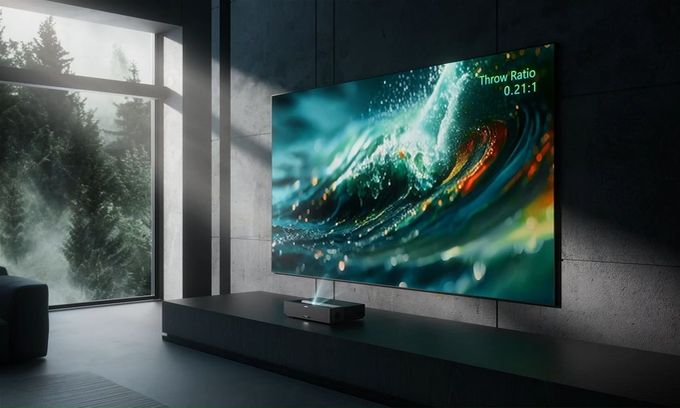As known, Formovie is a joint venture between Xiaomi and Appotronics, which hardly need an introduction.
Formovie projectors
For many years, Chinese giant Xiaomi has been one of the industry leaders in consumer and commercial electronics. Appotronics has developed and produces Advanced Laser Phosphor Display (ALPD) – based light engines. Today, they are most popular as a light source for projectors. Last year, Dangbei introduced X5 Ultra, which already uses the 5th generation of this technology. It has three colors of laser light sources and three colors of LED light sources, providing an unprecedented color gamut (120% / Rec. 2020, 165% / DCI-P3 and 210% /Rec. 709) and DeltaE < 1 color accuracy 'out of the box'. For reference, the coverage of the best models today does not exceed 110% in Rec. 2020 color space, and DeltaE < 3 is considered ideal even after calibration.
Previously, Formovie projectors successfully competed in Asian markets under the name Fengmi. In fact, Formovie Theater (September 2022) is an improved global version of the Fengmi T1. However, this year the company has already introduced its budget version called Formovie Cinema Edge. It’s cheaper ($ 2,000 vs $ 2,400) and brighter (1,900 vs 1,800 ISO Lumens), but supports only HDR10/NLG (no Dolby Vision and HDR 10+) and Dolby Audio / DTS-HD (no Dolby Atmos and DTS-X).
The new Theater Premium also has triple laser ALPD (Advanced Laser Phosphor Display) 4.0 RGB+ light source, which combines RGB lasers and phosphors. This improved light engine is 30% more powerful than ALPD 3.0, uses industrial-grade, long-lasting laser diodes, and drastically reduces the picture speckle. As known, this is one of the main problems of any single-laser light engine. Today Formovie Theater costs ~$ 2,400. The lounch price of Theater Premium is $ 3,500 and £ 2,600 in UK. However, the list of improvements is quite impressive.
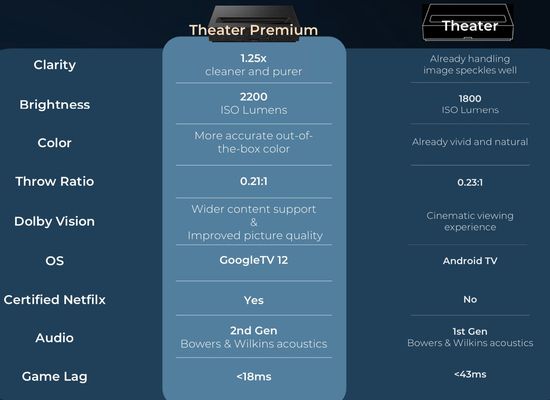
Formovie Theater Premium
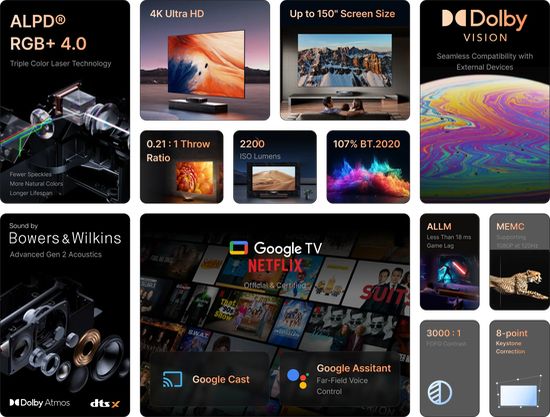
Main specs:
– triple laser ALDP RGB+ 4.0 light engine with color gamut up to 107% in BT.2020 standard.
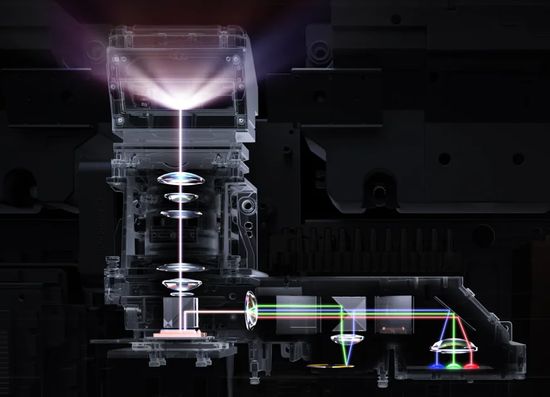
– 4K UHD (3,840 x 2,160) resolution with 0.47″ DMD display chip (TI DMD chipset with pixel shifting – based XPR / Xpanded Pixel Resolution technology).
A few years ago, this innovative technology radically reduced the price of 4K DLP models by playing 4K content using a relatively cheap 1080p chipset. In fact, the projector divides 8 million pixels of a 4K image into 4 parts of 2 million each. Then, it displays them sequentially using only 2 million micromirrors of the chipset, shifting the images by half a pixel relative to each other.
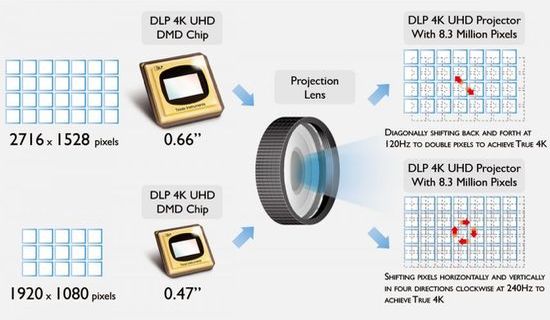
Of course, the projector is only displaying one 1080p image at any given time. But because of the high frequency, our brains perceive them as a single, higher-resolution image;
– 2,200 ISO lumens brightness;
– 80~150-inch screen diagonal with 0.21:1 throw ratio;
– 3,000:1 FOFO (Full on/off) contrast ratio;
– two full-range 15W Bowers & Wilkins Hi-Fi speakers;
– Dolby Audio, DTS/X and DTS-HD audio decoding;
– auto software motorized focus;
– omnidirectional manual 8 or 4 – point keystone correction;
– Bluetooth 5.0 and 2.4/5GHz WiFi 6 wireless connectivity;
– built-in Chromecast support and Google voice assistant;
– Far-field voice control, MEMC, Speckle elimination, Automatic Low Latency Mode (ALLM) for gaming.
Motion Estimation, Motion Compensation technology (MEMC) improves motion clarity for fast-moving content, which is important, for example, in sports or action films. The smoother playback with reduced motion blur and jitter is achieved by frame interpolation;
– (550 x 349.2 x 107.5mm)@9.8kg.
UST design and Audio
To a large extent, the ultra-popularity of UST projectors is due to their use as an alternative to traditional TV in the living room. Indeed, the formation of the projection using aspherical mirrors reduced the minimum projection distance to several tens of cm. In tern, the projector placement near the wall eliminated one of the main problems of mid-focal models, which form a big image from a distance of several meters. Of course, their placement closer to the center of the room creates the problem of wires on the floor. The children or pets in the family further aggravate it. Today it’s solved only with the help of a complex ceiling mount, which also radically limits the mobility of the projector. But reducing the throw ratio from 0.23:1 to 0.21:1 in Formovie Theater is hardly critical due to the lack of a problem. In fact, it reduces the minimum distance by ~ 10 cm (150″@42cm).
Premium version has an improved second-generation Bowers & Wilkins sound system. Specifically, the speakers are placed in a larger 990cc sound chamber, resulting in richer bass and clearer high-frequency sounds. The Theater Premium uses two full-range 15W Bowers & Wilkins Hi-Fi speakers for a woofer and tweeter for each side.
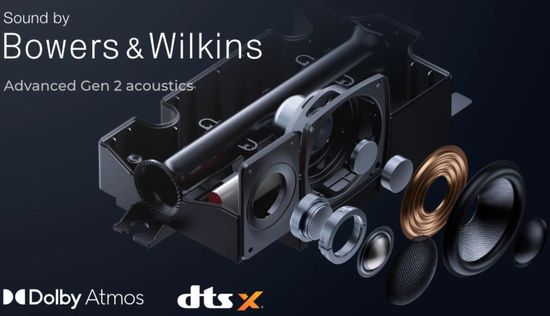
Superb high-frequency performance are ensured with 1″ Titanium Dome and High Quality Filtering Capacitor. The good level of low-frequency performance with precise bass and minimal distortion are created using 2.75” fiberglass-woven diaphragm and bass reflex port. In addition, it‘s Dolby Atmos / DTS-X compatible.
The sound volume may seem insufficient for a very large room. But overall, the projector creates a clear and rich audio scene. Frankly, most users can save money by not purchasing an external soundbar.
Formovie Theater vs Theater Premium
Improvements list:
– slight brightness increase – 2,200 ISO Lumens vs 1,800 ISO Lumens (ISO 21118 standard);
– higher color accuracy ‘out of the box’ – according to the company, the new projector uses tighter tolerances on its most color-accurate image mode. As a result, high color accuracy ‘out of the box’ actually eliminates the need for additional calibration;
– higher image quality – the developers are claiming a 1.25x improvement in clarity due to more effective speckle suppression and new lens;
– 2gen Bowers & Wilkins sound system;
– Dolby Vision Vivid picture mode with increased brightness for Dolby Vision content;
– a more complete web streaming platform – Google TV 12 OS and a native Netflix app vs Android TV platform without pre-installed Netflix in prior version.
Of course, user interface also provides easy access to other streaming apps, including YouTube, Amazon Prime Video, Hulu, Disney+, HBO Max and more;
– improved gaming performance – measured input lag was reduced to 18 ms vs 43 ms in the Theater, which corresponds to the segment of gaming projectors;
– slight decrease in throw ratio – 0.21:1 vs 0.23:1.
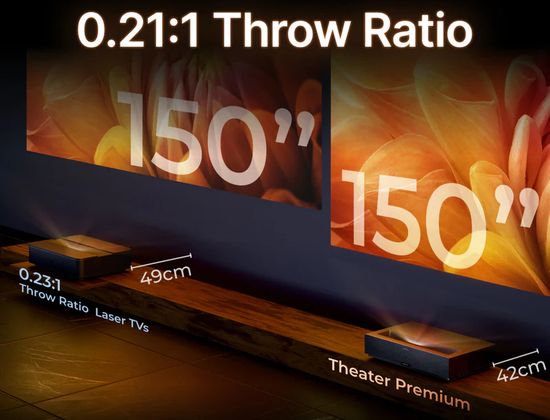
Of course, the $ 1,100 price increase ($ 3,500 vs $ 2,400) may seem like too much. But the developers tried to justify every extra cent and they succeeded. In fact, the Premium version offers significant improvements in all key criteria, including brightness, video processing, color accuracy, gaming, sound system and streaming platform. Moreover, the traditional correction of launch price can further improve the price-quality ratio.
Conclusion
The projector will have to compete with the new Hisense PX3-Pro and Samsung LPU9D:
– Hisense PX3-Pro – $ 3,500, 3,000 ANSI Lumens, 3,000:1 (FOFO) contrast, RGB Laser (110% of the BT.2020 color space), built-in 50W front-firing Harman Kardon speakers, Google TV;
– Samsung LPU9D – $ 6,000, 3,200 ANSI Lumens, RGB Laser (110% of the BT.2020 color space), built-in up-firing speakers and woofers – 40W 2.2.2ch audio, Samsung TV Plus + Gaming Hub.
Of course, Samsung is brighter and offers additional, but it’s much more expensive.
Hisense PX3-Pro offers almost identical specs the choice depends on secondary criteria, including personal attitude to brands, discounts, etc.
But competition with 100″ TVs is no less fierce. A few years ago it was practically nonexistent. The cheapest 100″ TVs started at $ 10,000 and reached $ 25,000. TCL 98R754 in 2022 with an announced price of $ 6,000 started a new trend. Today the companies have introduced several models at a very affordable price. This list, for example, includes Hisense 100U8K, TCL98QM751G and Samsung QN98Q80C priced from $ 2,200 to $ 5,000.
Of course, the projector image quality is less due to lower contrast and brightness. Today, only expensive LCoS projectors priced from $ 6,000 and more provide comparable contrast. Lower brightness is due to the use of reflected light flux by projectors, as opposed to direct radiation from the TV screen surface. As a result, at a comparable price, UST projectors offer a larger screen but inferior image quality.
Video presents Formovie Theater Premium.
